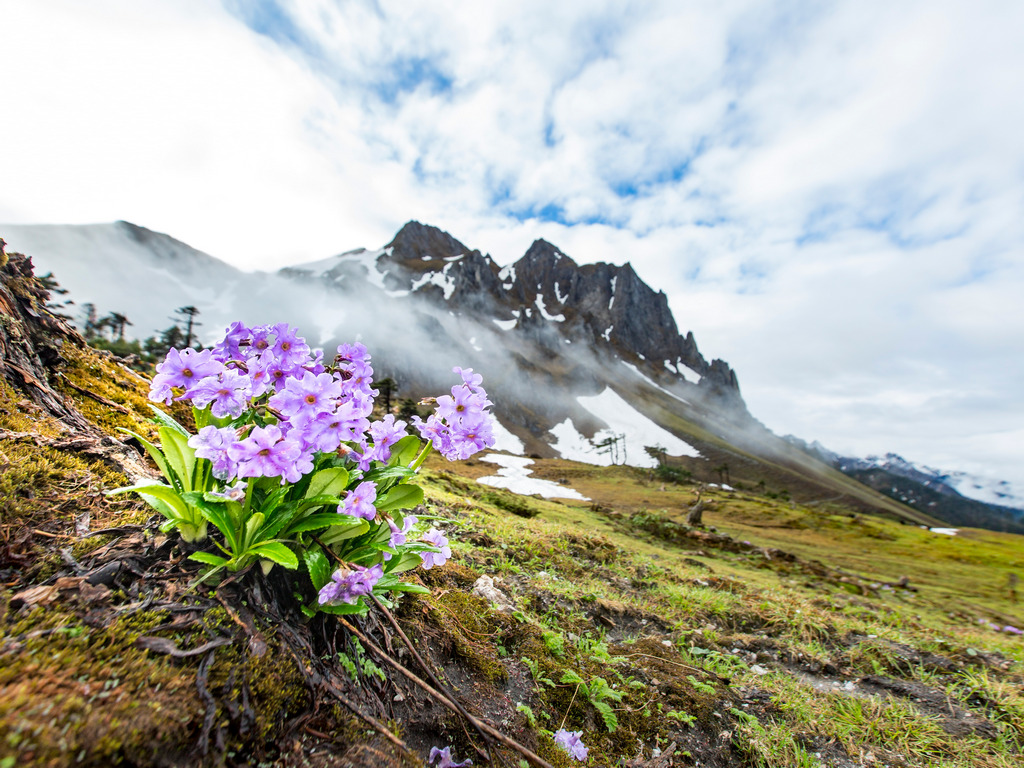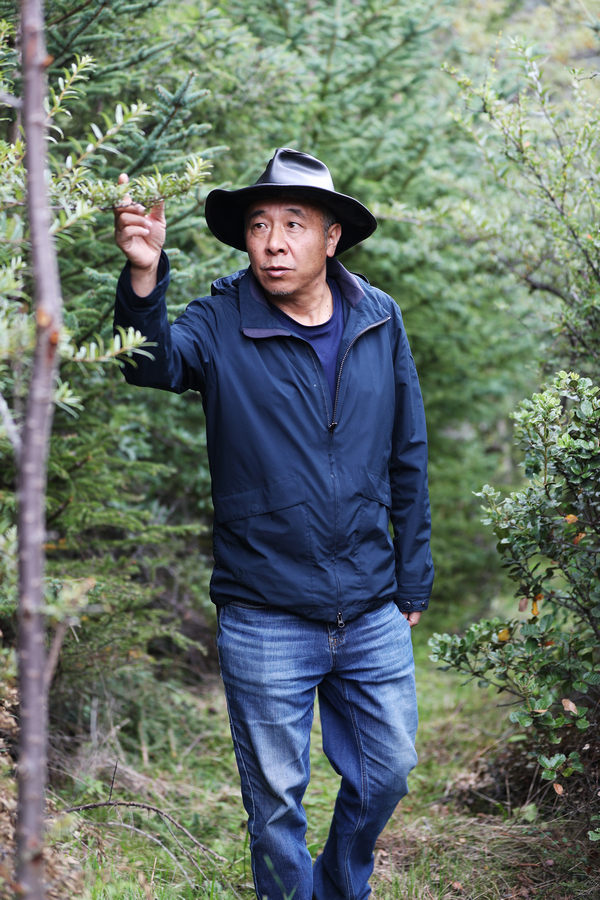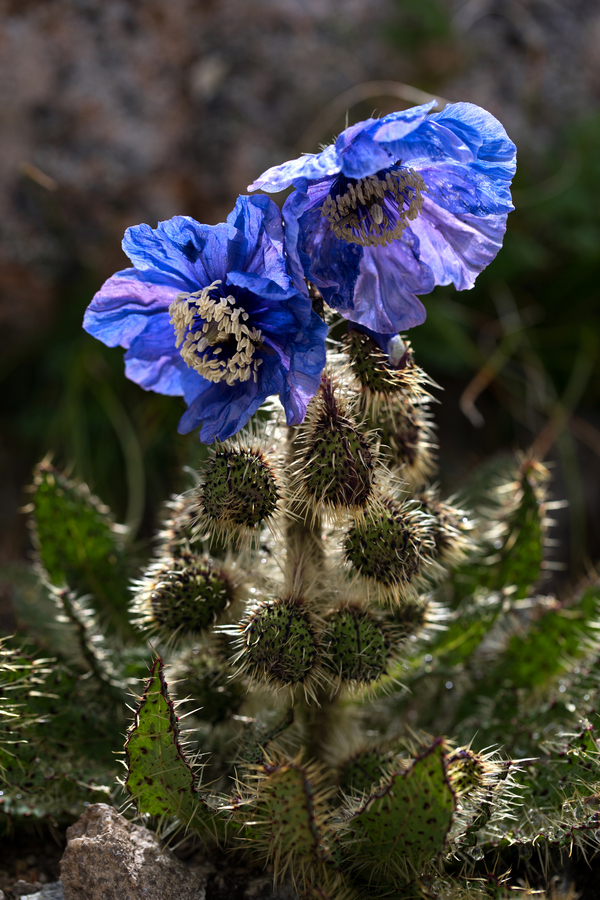Sky High Garden

In 1910, British botanical explorer George Forrest collected a bunch of fascinating yellow flowers he had never seen before in southwestern China’s Yunnan Province. The flower was Primula forrestii, a kind of primroses that grows on ledges of limestone rocks in northwestern Yunnan at altitudes ranging from 3,000 to 3,200 meters.
Primroses are mostly found in southwestern China, especially from the eastern Himalayas to the Hengduan Mountains. It is known as one of the three famous alpine wildflowers in China alongside the rhododendron and the gentian.
During his seven expeditions to China, Forrest collected more than 30,000 dried specimens for Western plant research institutions, of which 5,375 were previously unrecorded. His introduction of over 1,000 species of living Chinese plants divided European gardens into two periods: “before Forrest” and “after Forrest.” The world came to know that the Hengduan Mountains in southwestern China were a mecca for plant collectors and a cradle of garden-worthy plants.
Of the 500 species of primroses in the world, 296 are found in China, including 126 in Yunnan. The province's Diqing Tibetan Autonomous Prefecture alone has as many as 89 species.

The ruby fruits of Zhongdian hawthorn are a favorite food of many wild birds, and wildlife has gradually returned and multiplied in Shangri-La Alpine Botanical Garden. by Ma Gengping/China Pictorial
Alpine Botanical Garden
Located in northwestern Yunnan on the southeastern Qinghai-Tibet Plateau, Diqing boasts intact ecosystems characterized by snowy mountains, dense forests, and surging waters. The altitudes of the prefecture range from 1,600 to 6,740 meters, creating an ideal environment for various endemic plants.
Diqing is indeed a gene pool of rare species. It is home to 4,499 species of seed plants, 1,578 species of ornamental plants, 969 species of medicinal plants, 147 species of wild edible fungi, 99 species of mammals, and 248 species of birds. Generations of Chinese botanists dreamed of establishing an alpine botanical garden in the area to serve as a multi-functional platform for scientific research, production, education, tourism, scientific popularization, and academic exchange.

Fang Zhendong, director-general of the Shangri-La Alpine Botanical Garden, has cultivated millions of cold-tolerant plateau seedlings with his colleagues over the past two decades. by Dong Fang/China Pictorial
In 2001, Shangri-La Alpine Botanical Garden was built at an altitude of 3,200 to 3,600 meters in the northern suburbs of Diqing’s capital Shangri-La. Twenty years on, the botanical garden has sheltered more than 620 species of higher plants and more than 400 species of ex-situ conservation. Shangri-La, a tranquil paradise mentioned in James Hilton’s novel Lost Horizon, finally got its botanical garden and gene bank.
In September, clusters of ruby fruits make the Zhongdian hawthorn, the “city tree” of Shangri-La, even more eye-catching in the botanical garden. Its fruits can be used as a medicine to improve digestion and blood circulation.
Hawthorn is the favorite food of many wild birds. Amidst the hawthorn trees, 57-year-old Fang Zhendong, director-general of the botanical garden, stressed that the plant is helpful for keeping wild animals.
Fang’s hair is greying after his 35 years of botanical research since graduating from Yunnan University. Twenty years ago, Fang decided to establish an alpine botanical garden in low-latitude Diqing. The mountain where the garden is located was once a key passage along the Ancient Tea-Horse Road.
“Alpine plants are mainly found in specific environments in Diqing and they now face threats like habitat loss due to human activities,” Fang said. “The alpine botanical garden provides a platform for protection, research, exploration, science popularization, public experience, eco-tourism, and academic exchange related to plant diversity in the Hengduan Mountains.”
The botanical garden was built to serve as an ideal shelter without external disturbances. “Grazing livestock is kept outside the garden. The wild plants bloom and spread seeds safely. Many birds and small mammals can find food here, so wildlife gradually returns and multiplies.” In Fang’s opinion, the alpine botanical garden speaks volumes about biodiversity conservation in Yunnan.

Prickly blue poppy features open-faced flowers that are usually in shades of blue or reddish blue. The stalk that supports the flower is bent, so the flower is droopy. by Li Zhigang

Ghost plant ranges in height from 10 to 30 centimeters and the entire plant is translucent, ghostly white and sometimes pale pinkish-white, and commonly has black flecks. by He Jie
Shelter for Rare Plants
Identified as one of the most biodiverse places in the world, Yunnan boasts a large number of rare, endangered, and endemic higher plants. This region, occupying just 4.1 percent of China’s land area, is home to 50 percent of the country’s plants, birds, and mammals.
In recent years, Yunnan has built 13 in-situ and ex-situ conservation bases to protect species with extremely small populations and endangered wildlife and plants. Among the 13 bases, Shangri-La Alpine Botanical Garden is at the highest elevation. The Xishuangbanna Tropical Botanical Garden of the Chinese Academy of Sciences (CAS) manages a collection of more than 13,000 species of plants that creates a visual feast. More than 7,000 species of plants have been collected in the Kunming Institute of Botany of the CAS and its 15 specialized botanical gardens. Hekou County’s botanical garden dedicated to the conservation of plant species with extremely small populations displays many living fossil plants.
Thanks to the ideal condition inside Shangri-La Alpine Botanical Garden, Fang and his colleagues have cultivated millions of cold-tolerant plateau seedlings in the past two decades including Shangri-La Rheum nobile, Piptanthus, and Cotoneaster microphyllus.

Lion’s mane mushroom is an edible fungus identified by its long spines, occurrence on hardwoods, and tendency to grow a single clump of dangling spines. by Yu Jiang
Shangri-La Rheum nobile, a subspecies of the Lhasa Rheum nobile found on mountains in Lhasa in southwestern China’s Tibet Autonomous Region, possesses high medicinal value. It took nearly 10 years for Fang’s team to study its life cycle and identify its value. The dry roots of the plant can reduce excess heat, alleviate indigestion, and remove blood stasis. Rheum nobile has been planted in Jiefang Village near the botanical garden since 2017 and continues to generate considerable income for the local community.
“Introduction and domestication of Tibetan medicinal plants enriches the plant diversity in the botanical garden and inspires us to explore its sustainable development,” said Fang. “The practice not only increases the income of local people but also creates an empowering environment for wild plants.”

Dutchman’s pipe is a deciduous, woody, and climbing vine typically found in moist woods or near streams in the wild. by Zhao Tianhu
Fang continues introducing and breeding new plants. He recently led a team to collect wild rhododendrons in Potatso National Park. “We want to protect threatened species by breeding more of them,” he explained.
Today, Shangri-La Alpine Botanical Garden has established partnerships with botanical gardens, universities, and research institutions around the world including Missouri Botanical Garden, Central China Normal University, and the Kunming Institute of Botany of the CAS. “Frequent exchanges in the field of scientific research have pulled more people to participate in the development of our alpine botanical garden,” said Fang.